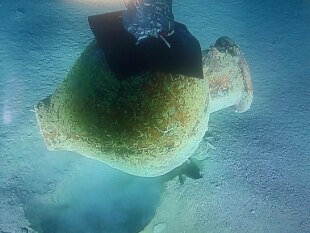Share
October 16, 2021 Recent studies by the National Superintendence for Underwater Cultural Heritage on the wreck identified in 2019 at 780 meters deep in the Otranto channel shed new light on the dawn of Magna Graecia. With the help of a wire-guided submarine vehicle (Remotely Operated Vehicle) and equipped with high-tech equipment it was possible to unearth part of the cargo of the wreck: twenty-two finds of fine ceramics and transport containers from the Corinth region which, thanks to the recent study conducted by the archaeologists of the Ministry of Culture, they have been dated around the first half of the 7th century BC.The finds - currently kept in the restoration laboratories of the Superintendency set up by Minister Franceschini in December 2019 as part of the reorganization of the ministry - constitute an exceptional find of great scientific importance. "The technologies usually used in the work of the industrial underwater practice of the 'oil & gas' sector, used under the careful control of the archaeologists of the Superintendency, made it possible to bring to the surface part of the cargo of the first wreck datable to the beginning of the 7th century BC found in the Adriatic Sea - explained the Superintendent, the underwater archaeologist Barbara Davidde and added - it is an event of exceptional importance, also for the technologies used for the recovery,made in the Italian seas at a depth of almost 800 meters ".
"The discovery gives us a historical data that tells the oldest phases of Mediterranean trade at the dawn of Magna Graecia, less documented by underwater discoveries, and of mobility flows in the Mediterranean basin - explained the Director of the Museums, Massimo Osanna, who visited the restoration laboratory of the National Superintendence for Underwater Cultural Heritage, on the occasion of the 60th International Conference of Studies on Magna Graecia, and continued - it is an intact load that sheds light on the first phase of Greek colonization in southern Italy, thanks also in the significant state of conservation that allows us to understand what they were carrying: not only foods such as olives, but also wine cups considered prestigious goods and much appreciated also by the Italic people "."These are in particular three Corinthian type A amphorae, ten Corinthian skyphoi, four Corinthian hydriai, three trilobed oinochoai in common ceramic and a jug of coarse dough, very common in Corinth. Very interesting is the pithos, recovered fragmentary - explains Davidde - with all its contents made up of skyphoi stacked inside it in ordered horizontal piles. At this stage, there are at least 25 intact, as well as several fragments pertaining to other cups. The total number of skyphoi and any other elements originally contained in the pithos will be defined through an excavation in the laboratory with the removal of the marine sediment ". In consideration of the importance of the wreck,the Ministry of Culture plans to proceed with the recovery of the entire load which is made up of about two hundred finds, still scattered on the seabed, of which a georeferenced mapping is already available, the restoration of the finds and the realization of archaeometric analyzes on the materials and archaeobotanicals on organic and vegetable residues that could still be present in the sediment that fills many of the recovered pottery, as for example in one of the Corinthian amphorae that returned the remains of olive pits.the restoration of the finds and the implementation of archaeometric analyzes on materials and archaeobotanicals on organic and vegetable residues that may still be present in the sediment that fills many of the recovered ceramics, such as in one of the Corinthian amphorae that returned the remains of olive pits .the restoration of the finds and the implementation of archaeometric analyzes on materials and archaeobotanicals on organic and vegetable residues that may still be present in the sediment that fills many of the recovered ceramics, such as in one of the Corinthian amphorae that returned the remains of olive pits .

